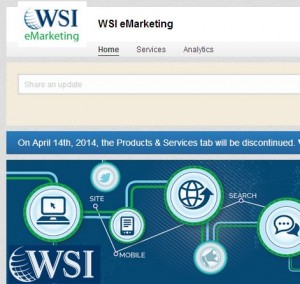by Rob Thomas
Recognised as an expert in ‘social selling’ reputation management, digital and mobile marketing, Rob is a professional speaker both in the U.S. and across Europe.Rob is also co-author on one of Amazon’s top sellers Digital Minds: 12 Things Every Business Needs to Know about Digital Marketing – wsiuk.so/DigitalMinds
In this blog, featured on his LinkedIn, UK-based WSI Internet Consultant, Rob Thomas writes about imminent demise of the LinkedIn Company Service/Product Pages.
Monday next week (April 14th) sees the removal of products and services from LinkedIn Company Pages.
Frustrating though it may be for those of us who’ve worked hard to refine our products and services pages and get good client recommendations on them, they are going and we have to be prepared. We have to make sure we have everything in place so we do not see a major adverse impact on our company pages.
The view of LinkedIn is that by now having dedicated Showcase pages you can build stronger relationships with members who want to follow specific areas of your business, while still keeping those who have a general interest in your overall business up to date with what’s going on.
There are 3 key things you need to do
- Set up your Showcase Pages
- Copy/recover your products / services recommendations
- Think about ways to use past company recommendations and what you’ll do with future ones (personal ones can still go on LinkedIn)
The reason I put them in this order is that even though the product page recommendations will disappear on the 14th along with the pages, there is still a chance for you to recover them from LinkedIn up until 30th May. Once the product pages go, they’re gone forever!
1. Set up your Showcase pages
Each product or service you want a dedicated presence for will need its own Showcase Page. This will allow you to share product/service specific information with your target audience. Your audience will now be able to follow the areas of your business they value most, in addition to the general company content you share. You can now focus your content even more and build relationships with specific audiences.
Your company page can have up to 10 showcase pages attached to it. It’s worth taking the time to think about the essential pages you need and what you’ll call them before you start setting them up.
Click on the down arrow next to Edit at the top of your company page (don’t click on the word edit, this takes you to your main company page information). Select ‘Create a Showcase Page’ and follow the instructions.
When putting in your banner images make sure there is a consistent brand message. You may want to vary them slightly depending on your product or service but remember, these pages can now be searched for and found independently of your main company page.
We’ve decided to set up 5 Showcase Pages for now – 4 covering our main client offerings across Digital Marketing, namely; Site, Search, Social & Mobile and the last one, a repository for past recommendations and client feedback , and a place that in future we’ll share case studies and other useful information for prospective clients doing their “due diligence” – take a look:
2. Recover/retain your recommendations
If like us you’ve worked hard to get satisfied clients who use your services to publicly recommend you, then you won’t want to lose the detail of those recommendations. In some instances you may well have the recommendation elsewhere too, but if not, you only have a limited time to copy the details or get them back from LinkedIn themselves.
The quickest way is to copy and paste all the recommendations in to a document of your own. If you haven’t got time to do this before they disappear then you can request the details of recommendations that were showing on your pages up to March 4th from LinkedIn. You’ve got until May 30th to do this.
We’ve created a PDF document which people can view or download. It’s stored in a location that allows it to be easily downloaded from a link (e.g. in your email signature) AND in the personal LinkedIn profile as a document somewhere relevant (e.g. Summary or Experience).
3. Think about ways to use past company recommendations and what you’ll do with future ones
Rightly or wrongly the ability of contacts to publicly recommend your company and the services you provide via LinkedIn is gone, and recommendations will now completely relate to individuals. If you haven’t already got a Google+ page for business now may be the time to think about making sure you get one. A Google+ page connects you with customers, whether they’re looking for you on Search, Maps, Google+ or mobile devices and a business page will show your reviews.
If you are going to copy your existing recommendations and plan to use them elsewhere, make sure you get the permission of the individual who gave you the recommendation before you do.
Whilst we will still seek personal feedback through LinkedIn (as for us it’s still THE B2B Social Technology), we will now be asking for feedback on the company via Google+. I guess it’s also a good reminder never to have all your eggs in one basket!!
Here’s an example of what we’ve done. The primary advantage of using Google+ of course is that, as they are “independent reviews” (the reviewer must be logged-in to a validated Google+ account themselves) not only can the viewer see they are real and not “made up” but they’re indexed straight into Google’s SERPS results too!





